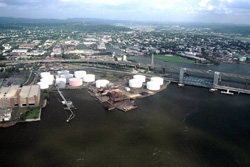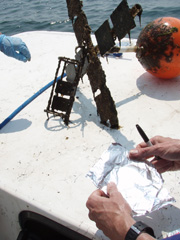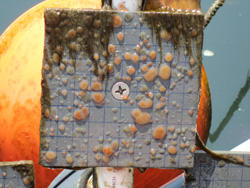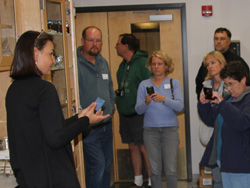 |
|
| SEARCH | THE COURTSHIP OF EVA AND BOB | ||||||||
|
Passive Water Samplers and Basic Observation Buoys (BOBs) for Monitoring Water Quality in Long Island Sound The Science Challenge – Pollutant and Biological Time Series Observations 
To understand the individual and collective impacts of these myriad factors requires that we measure a wide range of variables at time and space scales that are adequate to measure the natural and human-induced variability. This has been the motivating factor for the development of both the National Science Foundation’s (NSF) sponsored Ocean Observing Initiative (OOI) and the National Oceanic and Atmospheric Administration (NOAA) sponsored Integrated Ocean Observing System (IOOS). The Technology Solutions Passive Samplers 
Recently, passive sampling technologies have been developed that provide a means to measure contaminant levels over a longer time frame and average the concentration of the contaminant over the period the sampler is deployed. Passive samplers work by providing a substrate that has been impregnated with reference compounds that correspond to contaminants targeted for measurement. When deployed, these samplers equilibrate the contaminants in the environment with the receiving marker over a period of time to provide an averaged concentration of the contaminant. One compound that has been used, identified by Dr. Penny Vlahos at the University of Connecticut as a viable substrate, is Ethylene Vinyl Acetate (EVA). Basic Ocean Buoys A Basic Observation Buoy (BOB) is a floating platform with capacity to carry a suite of environmental sensors. A BOB can be moored to the bottom in open water or tied to a dock in coastal waters. Based on concepts developed by Doug Levin, Ph.D., located at NOAA’s IOOS (Integrated Ocean Observing System) Program Office, BOB is an exciting collaborative being developed to link scientists and educators. The project allows teachers and students to become directly involved with longer-term monitoring of the environment based upon a simple technology of their own design and construction. To date, the BOB project has centered around precollege to undergraduate level student-designed, built and deployed buoys that host data collection, storage, and in some cases transmission capabilities. COSEE-TEK staff reviewed the original BOB design and engineered a new design to effectively support the EVA passive samplers and settling plates. The modified design relied upon more affordable commercial fishing trawl floats to provide the same level of buoyancy and, for the benefit of this project, provided a more compact, cost effective solution for ocean observation. . Biological Settling Plates 
Drs. Robert Whitlatch and John Hamilton of the University of Connecticut have been monitoring the dynamics of settlement in Long Island Sound for over a decade using PVC plates that are 10 cm x 10 cm and marked with a 1 cm x 1 cm grid. This allows for rapid assessment of the percentage of the plate that has been covered by the settled organisms. The Teacher Technology Experience – The Courtship of EVA and BOB 
In addition to their BOB, teachers were provided with a cage to hold three passive samplers, 12 settling plates and an Onset “Hobo” long term temperature and light monitoring device. The teachers deployed their BOB with the EVA samplers and settling plates in their local waters following the summer TTE. The EVA’s will be retrieved/redeployed on a monthly interval in the fall, which will be adequate for the EVA sensor to adsorb the contaminants of interest. To date, two participating teachers have deployed their BOBs and have returned one set of EVA samplers for analysis in Dr. Vlahos’s lab. They also have collected temperature and salinity data at each of the BOB sites. The EVA sensors are being analyzed by a UConn undergraduate student who is also leading the EVA sensor preparation, data collection and mass spectrometer analysis in Dr. Vlahos’ lab.? The teachers will have the opportunity to bring small teams of students from their school to Dr. Vlahos’s lab and be immersed in the technologies, procedures and results of the data analysis. The location, images and data from the initial three BOBs deployed by COSEE-TEK partner, Project Oceanology, have been plotted using Google Earth and are available on the COSEE-TEK website. As the two schools in Long Island Sound come on line, the location and data from their BOBs will also be plotted using Google Earth to promote the exploration, analysis and comparison of the data in a geospatial context by the teachers and students. The COSEE-TEK website will be an interactive repository for this data, allowing the teachers to download and upload data to a Google Docs server. |






